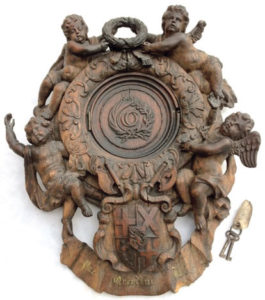
They found the head of Oliver Cromwell and sent it to Cambridge College, but they never found his body – intact – ever. Where are Oliver Cromwell‘s bones? The 17th century Lord Protector of England died of natural causes, albeit disgraced, in 1658. AT’s plaque brings back the 19th century speculation – where is Oliver?
They buried Cromwell’s body, once, in Westminster Abbey. Yet after the Restoration of the English Monarchy in 1660, Cromwell – even dead – was such a hated figure that the English dug his three-year’s dead body out of Westminster Abbey’s lead-lined vaults. They actually strung him up on a gallows to be hung. Already dead, this didn’t do much. So the English took him down and decapitated him. His head ‘lives’ in Cambridge but what of his bones?
AT’s plaque tells part of the story.
In the 19th century his body parts in pieces were discovered scattered from London to Yorkshire. Although after 200 years it might have been hard to tell Oliver’s bone from a chicken bone. Still the Victorian fascination for death, great white men, ghosts, murder and all things funereal gave rise to a witch hunt style version of a Cromwellian Cult of Relics. AT’s plaque is not 17th century Cromwellian, but may hold part of the Cromwell story – literally!
When AT’s wife bought this in London they told her this piece belonged to Oliver Cromwell, Lord Protector of England, Scotland and Ireland from 1653-58. This piece is a fruitwood hanging plaque framed cartouche of foliate leaves and four flying putti circling around a hinged tiny round box carved with a laurel and feather garland around the initials O. C. intertwined. An heraldic shield shows the Cross of St. George (England), the Saltire Cross of St. Andrew (Scotland), the Stringed Harp (Ireland), centered by the Lion Rampant (London). The motto beneath of the Guilloche (wood carved to look like ribbon) reads Pax Queritur Bello – Peace is Sought by War.
The shield appears almost identical to those we know of the Cromwellian coat of Arms, and the motto definitely belongs. BUT the STYLE of the plaque is NOT 17th century. The style comes across flowery, feminine, overblown and religious. All these elements are decidedly not Cromwellian.
The Influence of Oliver Cromwell
Cromwell influenced everything, especially 180,000 men who died in the two English Civil Wars, and the look of 17th century decorative arts. He became the only non-royal to sit on the throne of England. He overthrew the Stuart monarchy of Charles I. Because Oliver Cromwell hated the vanity and sensuality of the High Church of England which Charles I headed.
Religious strife tore apart England, pre-Cromwell. The Calvinists, the Laudianists, the Arminianists, the High Church, and – of fortune to the early settlers in America – the Puritans, all claimed the Way to God. Charles I among this broil facilitated a semi-reunion with the Roman Catholic Church, as head of the high Church of England, he was divinely ordained.
Oliver Cromwell himself was no kind of man to decorate his plaques with delicate angels. He got down to business, and signed Charles I’s death warrant after which the King hung in 1649.
Cromwell, more than likely a closet Puritan, became famous for the pillage of anything religiously visually appealing. He liked stricter things. For instance his chair, a straight-backed armless square oak leather-upholstered electric chair, looked like a piece of nightmarish seating furniture. Cromwell never stood for this type of plaque with its flying winged naked baby boy angels around his initials! Why then did the plaque’s maker go to such trouble to get the historicism right and not the STYLE?
Fascination with Sex and Death
The mid 19th century in England held no original style of anything, not in art, furniture, clothing, or architecture. The psychology: if a society fears the fast moving, growing industrial present, bury your head in the sand of the past. All of Britain, stylistically, did that for 50-years in the decorative arts. Pure style anything didn’t exist. Add to that the sexual repression famous in the Victorian age, and you spark a culturally collective fascination with sex, and its cousin, death.
AT, you have such a reminder here in your plaque, a sweet Cromwellian bone holder with naked boys. You think I jest? If my lover died in 1840, I’d have cut his hair and made a black-framed wall plaque out of it. Victorians loved death!